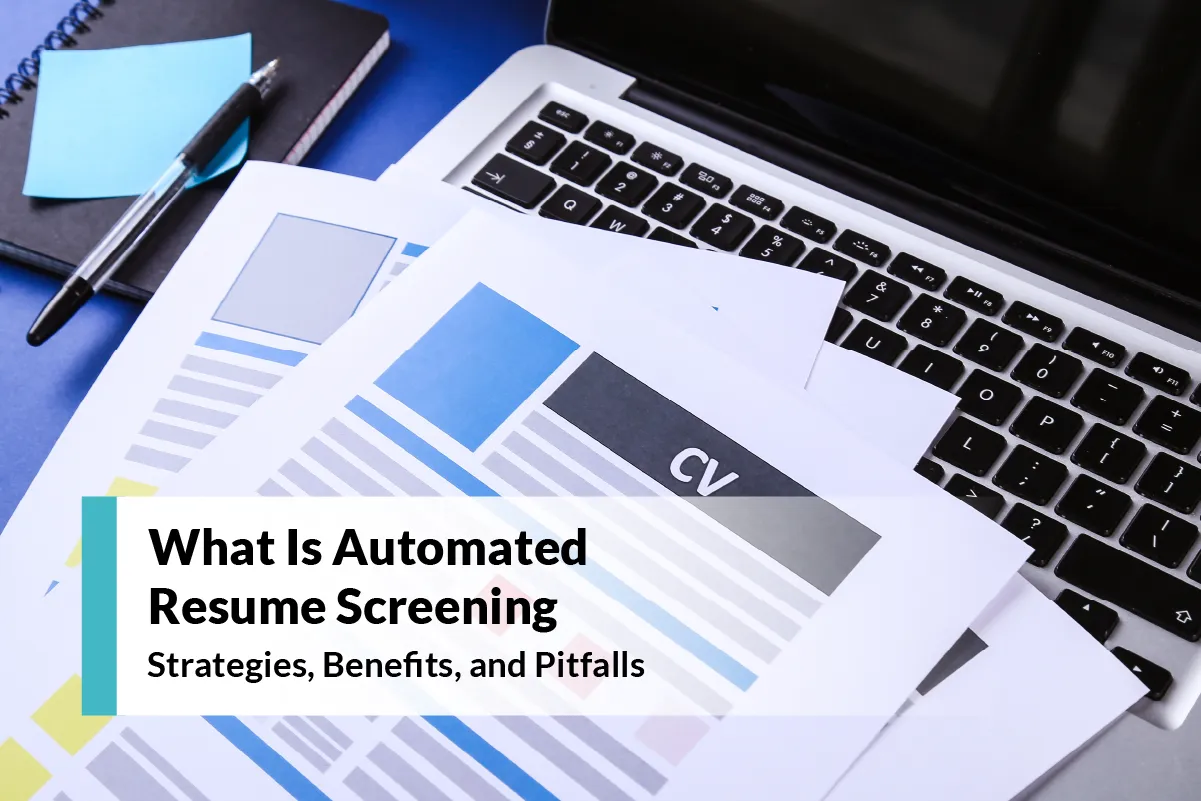In today’s competitive job market, companies receive an overwhelming number of resumes for each job posting.
Automated resume screening stands at the forefront of modern recruitment, streamlining the hiring process by efficiently filtering through vast numbers of applications.
In this article, our guide will offer an insightful overview of how this technology benefits recruiters by enhancing candidate experience, reducing hiring times, and minimizing bias while also highlighting its limitations, such as potential misinterpretation of context and the risk of overlooking qualified talent due to keyword dependency.
What is Automated Resume Screening?
Automated resume screening process involves using software (often within an ATS) to evaluate resumes of candidates automatically, so that the recruiters can quickly identify top candidates and focus their attention on those who meet the requirements.
Automated resume screening guarantees a thorough and fair procedure for all applicants. Rather than being judged by the recruiter’s subconscious prejudice, a machine simply pulls the relevant experience and education from each candidate and rates them based on the best fit to the job description.
An Applicant Tracking System (ATS) is a software that helps employers manage job applications efficiently. It organizes, stores, and tracks candidate information, including resumes, cover letters, and other application materials. ATS software scans resumes for keywords, skills, and qualifications relevant to the job description. It ensures consistency in the hiring process and helps manage large volumes of applications.
How does Automated Resume Screening work?
Automated resume screening works by comparing resumes to a job description or a set of keywords that reflect the desired skills, experience, and education for the role.
The ATS software scans each resume and assigns a score based on how well it matches the criteria. The resumes with the highest scores are then ranked and forwarded to the next stage of the hiring process, while the rest are rejected or archived.
ATS programs categorize your resume into different sections, such as work experiences, skills, education, and contact information. The software then searches for specific keywords and phrases related to the job and company you are applying to.
Companies may use ATS software to screen resumes received through emails, online portals, or other digital methods.
The exact algorithm and logic behind automated resume screening may vary depending on the ATS software and the employer’s preferences. Some factors that may affect the resume screening score include:
- The number and frequency of keywords and phrases that match the job description
- The format and layout of the resume
- The length and relevance of the work history and education sections
- The use of industry-specific terms and acronyms
- The presence of spelling and grammar errors
- The consistency and accuracy of the information
According to Fortune 500, over 95% of organizations use an ATS to simplify recruiting. Additionally, there’s a growing trend among small and medium-sized businesses to adopt ATS software.
Benefits of the Automated Resume Screening
Automated resume screening can offer several advantages for employers, such as:
- Improve candidate experience
- Eliminate bias
- Select qualified candidates with ease.
Let’s break it down!
1. Improve candidate experience
By using automated resume screening, employers can reduce the time and effort required to review hundreds or thousands of resumes manually. This can improve the candidate experience by providing faster feedback and reducing the chances of human error or bias.
Additionally, automated resume screening can help employers communicate more effectively with candidates, as they can send personalized messages and updates based on their resume screening status.
2. Eliminate bias
Another benefit of automated resume screening is that it can help employers eliminate or reduce bias in the hiring process.
Bias can occur when recruiters or hiring managers make decisions based on subjective factors, such as personal preferences, stereotypes, or emotions, rather than objective criteria.
Bias can lead to unfair or discriminatory hiring practices, as well as lower the quality and diversity of the talent pool.
By using automated resume screening, employers can ensure that resumes are evaluated based on the same standards and criteria, regardless of the candidate’s personal characteristics, such as age, gender, race, or ethnicity.
3. Select qualified candidates with ease.
Automated resume screening is a useful tool for employers to quickly and easily select the most qualified candidates for a job, allowing employers to filter out resumes that do not meet the minimum qualifications or requirements for the job.
Additionally, automated resume screening can help employers compare and contrast candidates based on their resume screening scores. This approach ensures the hiring decision is based on data and helps employers identify any potential talent gaps or areas for improvement in their recruitment process.
Limitations of Automated Resume Screening
Despite its benefits, automated resume screening also has some limitations and challenges, such as:
1. Lack of contextual understanding
One of the main limitations of automated resume screening is that it lacks contextual understanding and nuance. Automated resume screening relies on keywords and phrases to match resumes to job descriptions, but it cannot capture the meaning and context behind them.
For example, automated resume screening may not recognize synonyms, abbreviations, or variations of keywords, or it may assign different weights to the same keywords depending on their location or frequency in the resume. Additionally, automated resumes may not consider a candidate’s achievements or the relevance of their skills to the specific role or industry.
2. Overly rely on specific keywords or phrases.
Another limitation of automated resume screening is that it may overly rely on specific keywords or phrases to screen resumes and ignore other important aspects of the candidates’ profiles. For instance, automated resume screening may favor resumes that contain the exact keywords or phrases that match the job description. Still, it may overlook resumes that use different terms or expressions to describe the same skills or experience.
Moreover, automated resume screening may not consider the candidate’s soft skills, such as communication, teamwork, or problem-solving, which are often essential for the job but hard to quantify or measure.
3. Risk of overlooking potential talent
A third limitation of automated resume screening is that it may risk overlooking potential talent that does not fit the predefined criteria or expectations. Automated resume screening may reject or discard resumes that do not meet the minimum qualifications or requirements for the job. Still, it may also miss out on candidates with transferable skills, potential, or passion for the role.
Furthermore, it may exclude candidates with unconventional backgrounds, such as career changers, freelancers, or entrepreneurs, who may bring valuable insights, perspectives, or experiences to the organization.
Automated Resume Screening Checklists for Employers
To overcome the limitations and challenges of automated resume screening and enhance its effectiveness of automated resume screening, employers can implement a series of practical steps and techniques:
Step #1. Define clear job requirements.
The first step to optimize the resume screening process is to define clear and realistic job requirements. Employers should identify the essential skills, experience, and education required for the role and avoid adding unnecessary or unrealistic qualifications that may limit the talent pool or deter qualified candidates. Use clear and specific language to describe the job requirements and avoid vague or ambiguous terms that may confuse or mislead candidates.
Step #2: Develop relevant keywords and phrases.
A way to improve the resume screening process is to create keywords and phrases that match the job criteria.
Employers should conduct thorough research to identify the most frequently used terms and expressions that are relevant to their industry or profession. This will help them to match the required skills, experience, and education of the candidates they are looking for. Moreover, a variety of keywords and phrases are important to ensure that they capture the ways in which potential candidates may describe their qualifications.
Step #3: Customize screening criteria
To optimize the resume screening process, tailor the screening criteria to the particular role and organization. Employers should modify the screening criteria based on the level, function, and nature of the role, as well as the culture, values, and goals of the organization. You should also give priority to the most important and relevant criteria and assign appropriate weights or scores to them.
Note: regularly test and review the screening criteria and make necessary changes or improvements.
Step #4: Mitigate bias in screening algorithms.
To optimize the resume screening process, employers should be aware of the potential sources and effects of bias and take steps to prevent or reduce them. Use objective and fair criteria to screen resumes and avoid using factors that are not relevant or related to the job, such as personal characteristics, hobbies, or interests.
Note: Employers should regularly audit and monitor the screening algorithms and check for any discrepancies or anomalies in the screening results.
Step #5: Provide training for HR personnel.
Providing training for the HR personnel who are involved in the resume screening process is important to optimize the resume screening process. Employers should educate and train the HR personnel on using the ATS software effectively and efficiently and interpreting and evaluating the resume screening scores and rankings.
Encourage and empower the HR personnel to use their judgment and discretion to complement the resume screening process and to review or reconsider resumes that may have been overlooked or underrated by the ATS software.
Step #6: Monitor screening metrics
Employers should track and analyze the data and feedback from the resume screening process and evaluate its performance and impact. Some metrics include the number and quality of resumes screened, the time and cost of screening, the conversion and retention rates of candidates, and the satisfaction and engagement of candidates and employees. Employers should also use the screening metrics to identify and address any issues or gaps in the resume screening process and to make data-driven decisions and improvements.
Step #7: Offer a positive candidate experience.
Employers should ensure that the resume screening process is transparent and respectful and that candidates are informed and updated about their status and progress.
- Provide constructive feedback and guidance to candidates who are rejected or need improvement and appreciate and recognize candidates selected or hired.
- Offer a positive candidate experience so that employers can enhance their personal branding and reputation and attract and retain more talent.
Hire Better with Boulo!
Automated resume screening and ATS tools can help employers save time and resources by efficiently screening a large number of resumes and identifying the most qualified candidates while avoiding the pitfalls and, ultimately, achieving better hiring outcomes.
Boulo’s GROW plan offers automation features and a human touch from dedicated hiring experts to ensure getting high-qualified candidates.
Let’s work together and post a job on Boulo today to find and hire the best talent for your organization!

